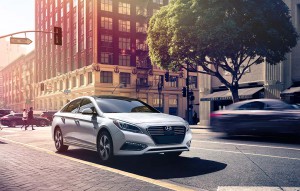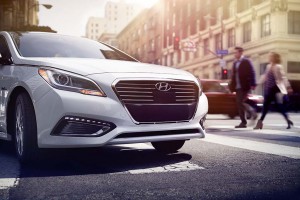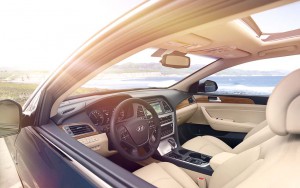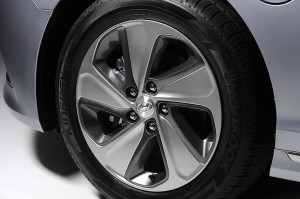Initially slow to embrace alternative powertrain technology, Hyundai is determined to catch up with green rivals like Toyota and Honda. It was the first to market with a retail hydrogen fuel-cell vehicle and it is about to update its original Sonata Hybrid for 2016 – while also adding its first plug-in hybrid model.
The timing likely isn’t the best. With gasoline prices running about a dollar lower than a year ago, and likely to say depressed for a while, demand for battery-based vehicles has taken a dive. But based on a day’s drive of the two new Korean models, green-minded buyers looking for alternatives would be well advised to check out the 2016 Hyundai Sonata Hybrid and Sonata Plug-in Hybrid.
The plug-based model, in particular, offers the longest range of any midsize PHEV on the U.S. market and its gas-electric driveline provides one of the smoothest, most transparent rides of any plug-in we’ve so far tested.
Despite the slump in demand for hybrids, plug-ins and pure battery-electric vehicles, manufacturers are rushing these alternatives to market as they struggle to meet rapidly escalating U.S. fuel economy standards that will jump to 54.5 mpg by 2025.
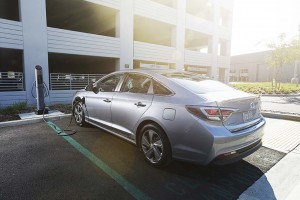
The 2016 Hyundai Sonata Plug-In Hybrid needs less than three hours to recharge its lithium battery pack.
(Lack of places to tank up limiting sales of Hyundai’s Tucson Fuel-Cell Vehicle. Click Here for more.)
Hyundai launched the first version of the Sonata Hybrid in early 2011. That version – and the update that followed two years later – were based on the radically styled sixth-generation sedan. Hybrid production continued using that edgy body style even after Hyundai launched the gen-seven Sonata last year.
The new version of the Sonata Hybid, as well as the first-ever Sonata Plug-In Hybrid, finally catch up. They both used the latest sedan’s more toned-down styling, though the battery models get some exterior tweaks primarily designed to improve their aerodynamics.
These include a unique front fascia and headlights, active grille shutters – which close when engine cooling demands are light – air curtains to reduce front wheel well drag, wind-cheating wheels, rear aero bumpers and a rear spoiler and diffuser, and an underbody cover. The payoff is significant, Hyundai claiming a drag coefficient of just 0.24, which matches that of Tesla’s Model S.
Drag is the enemy of efficiency, of course, so the better a vehicle is at cheating the wind the better its fuel economy – and range when operating on battery power alone. Hyundai expects to deliver 24 miles in electric mode, at speeds up to 75 mph. Preliminary estimates are for 93 MPGe, or miles per gallon-equivalent, and 40 mpg in Combined gas-electric mode.
The plug-in version of the 2016 Sonata pairs a 154-horsepower gas engine with a 67-hp electric motor drawing current from a 9.8 kilowatt-hour lithium-ion battery. Because of the vagaries of hybrid production, the package only produces a peak 202 horsepower.
That’s nine more than the standard Sonata Hybrid which uses the same 2.0-liter direct-injection gas engine but a smaller, 51-hp electric motor. The HEV edition draws power from a 1.62 kWh Lion battery pack. The SE version is rated at 44 mpg City, 40 Highway and 42 Combined. The upgraded Limited model cuts that to 43/38/41.
Both the 2016 Hyundai Sonata Hybrid and Sonata PHEV use a 6-speed automatic gearbox.
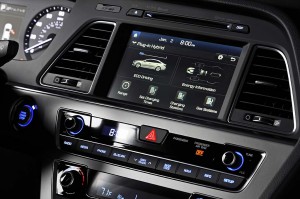
The 2016 Sonata PHEV comes with standard navi and several features to track battery use and mileage.
The plug model can be recharged in less than three hours using a 220-volt Level II charger. Surprisingly, Hyundai opted not to offer a high-speed Level III system. It is offering an industry-first lifetime warranty on the battery. But there’s an asterisk to that deal: it applies only to the car’s first retail owner.
(Battery-car buyers are younger, more affluent than typical car shoppers. Click Here for more on the new study.)
In the first-generation Sonata Hybrid, the large battery pack ate into the midsize sedan’s trunk space. Hyundai’s new lithium pack is not only more powerful but also smaller and lighter, and fits into the space under the cargo bay where a spare tire might otherwise go. The larger battery in the PHEV, however, still cuts into cargo space a bit, which here measures an acceptable 9.9 cubic feet – still larger than both the Ford Fusion Energi and Honda Accord Plug-In.
Both models feature some interior upgrades compared to the standard-issue Hyundai Sonata, and the PHEV gets navigation as a standard feature, displayed on an 8-inch LCD touchscreen. It also displays a variety of battery-centric data points, including a driver’s “eco score.”
The new models add several useful features to improve fuel economy and battery range, including a system that improves efficiency when coasting. The PHEV can be shifted between Electric Mode, Hybrid Mode and a Battery-Charging Mode. The latter allows the vehicle to reclaim energy when power demands are light. That way, a driver could later switch to full electric operation, say, in town, rather than on the highway.
Using Hyundai’s BlueLink telematics system, meanwhile, an owner can remotely check the vehicle’s state of charge, pre-set the time to charge in order to access lower night time electric rates, and fire up the climate control system while connected to an electric outlet – to minimize energy needs and preserve the battery charge.
We had the chance to drive both the 2016 Hyundai Sonata Hybrid and the Sonata Plug-In Hybrid during a long run down the Southern California coast and up into the hills near San Diego. The overall impression was generally quite positive. While acceleration wasn’t quite a match for the gas model it was more than acceptable.
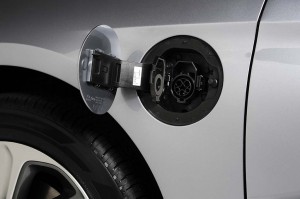
The Sonata PHEV can charge in less than 3 hours with a Level II charger - but offers no Level III capability.
What was particularly impressive was the fact that the drivetrain on both HEV and PHEV models switched from pure electric to hybrid modes seamlessly. At times, you could barely hear the 2.0-liter inline-four fire up – or shut down again. There was none of the notable shake that we’ve come to expect on many of the other hybrids and plug-ins now on the market.
The electric power-assist steering proved as good as that on the standard Sonata, though still no benchmark in the segment. A pleasant surprise was the suspension feel on the Sonata Hybrid. That was enhanced not only by careful tuning of bushings and springs but the lower position of the HEV’s battery pack. The large mass of the plug-models battery was a little more apparent, with a bit of a tail-heavy feel to the sedan.
While the mileage numbers Hyundai quoted still have to be confirmed by the EPA we turned in 42.9 mpg with the Sonata Hybrid and a full 99 mpg with the PHEV. We had a full battery charge when we started out with the plug model, we need note, but we also put in some miles on Interstate 5 running in the 65 to 80 mph range.
At peak, the original hybrid model briefly accounted for nearly 12% of overall U.S. Sonata sales. That figure has fallen sharply over the last year – along with demand for all battery-based vehicles. Hyundai officials were notably reticent to discuss sales or share numbers for the 2016 Hybrid and Plug-In models. Barring a sudden surge in gas prices, the segment is likely to remain weak for some time.
That said, the 2016 Hyundai Sonata Hybrid and Sonata Plug-In Hybrid are two of the better models in their niche, and buyers who still focus on fuel economy should certainly include them when comparison shopping.
The HEV will go on sale across the U.S. this summer. The Sonata Plug-in will follow in autumn, initially in just California and Oregon. It will then expand to eight other states that have copied California’s strict Zero-Emissions Vehicle standards. Hyundai officials suggested buyers in the rest of the country will be allowed to special-order the PHEV which may eventually roll out nationwide if the demand is there.
As for pricing, the outgoing 2015 Hyundai Sonata Hybrid starts at $30,325. Expect figures for the 2016 models to come closer to their respective on-sale dates.
(GM expects to fall short of its goals for plug-ins, battery-electric vehicles. Click Here for the story.)

